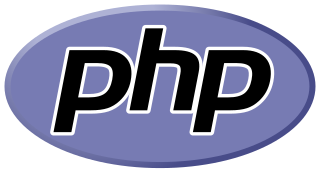
The Apache HTTP Server is a free and open-source cross-platform web server, released under the terms of Apache License 2.0. It is developed and maintained by a community of developers under the auspices of the Apache Software Foundation.
The Comprehensive Perl Archive Network (CPAN) is a software repository of over 250,000 software modules and accompanying documentation for 39,000 distributions, written in the Perl programming language by over 12,000 contributors. CPAN can denote either the archive network or the Perl program that acts as an interface to the network and as an automated software installer. Most software on CPAN is free and open source software.

In computing, Common Gateway Interface (CGI) is an interface specification that enables web servers to execute an external program to process HTTP or HTTPS user requests.

PHP is a general-purpose scripting language geared towards web development. It was originally created by Danish-Canadian programmer Rasmus Lerdorf in 1993 and released in 1995. The PHP reference implementation is now produced by the PHP Group. PHP was originally an abbreviation of Personal Home Page, but it now stands for the recursive acronym PHP: Hypertext Preprocessor.
Server-side scripting is a technique used in web development which involves employing scripts on a web server which produces a response customized for each user's (client's) request to the website. Scripts can be written in any of a number of server-side scripting languages that are available. Server-side scripting is distinguished from client-side scripting where embedded scripts, such as JavaScript, are run client-side in a web browser, but both techniques are often used together. The alternative to either or both types of scripting is for the web server itself to deliver a static web page.

A web server is computer software and underlying hardware that accepts requests via HTTP or its secure variant HTTPS. A user agent, commonly a web browser or web crawler, initiates communication by making a request for a web page or other resource using HTTP, and the server responds with the content of that resource or an error message. A web server can also accept and store resources sent from the user agent if configured to do so.
In web applications, a rewrite engine is a software component that performs rewriting on URLs, modifying their appearance. This modification is called URL rewriting. It is a way of implementing URL mapping or routing within a web application. The engine is typically a component of a web server or web application framework. Rewritten URLs are used to provide shorter and more relevant-looking links to web pages. The technique adds a layer of abstraction between the files used to generate a web page and the URL that is presented to the outside world.

The Microsoft Windows Script Host (WSH) is an automation technology for Microsoft Windows operating systems that provides scripting abilities comparable to batch files, but with a wider range of supported features. This tool was first provided on Windows 95 after Build 950a on the installation discs as an optional installation configurable and installable by means of the Control Panel, and then a standard component of Windows 98 and subsequent and Windows NT 4.0 Build 1381 and by means of Service Pack 4. The WSH is also a means of automation for Internet Explorer via the installed WSH engines from IE Version 3.0 onwards; at this time VBScript became means of automation for Microsoft Outlook 97. The WSH is also an optional install provided with a VBScript and JScript engine for Windows CE 3.0 and following and some third-party engines including Rexx and other forms of Basic are also available.

lighttpd is an open-source web server optimized for speed-critical environments while remaining standards-compliant, secure and flexible. It was originally written by Jan Kneschke as a proof-of-concept of the c10k problem – how to handle 10,000 connections in parallel on one server, but has gained worldwide popularity. Its name is a portmanteau of "light" and "httpd".
The Web Server Gateway Interface is a simple calling convention for web servers to forward requests to web applications or frameworks written in the Python programming language. The current version of WSGI, version 1.0.1, is specified in Python Enhancement Proposal (PEP) 3333.

A LAMP is one of the most common software stacks for the web's most popular applications. Its generic software stack model has largely interchangeable components.

Catalyst is an open-source web application framework written in Perl. It closely follows the model–view–controller (MVC) architecture and supports a number of experimental web patterns. It is written using Moose, a modern object system for Perl. Its design is heavily inspired by frameworks such as Ruby on Rails, Maypole, and Spring.
Web server software allows computers to act as web servers. The first web servers supported only static files, such as HTML, but now they commonly allow embedding of server side applications.
The acronyms BAPP and BAMP refer to a set of open-source software programs commonly used together to run dynamic websites or servers. This set is a solution stack, and an open source web platform.
A webform, web form or HTML form on a web page allows a user to enter data that is sent to a server for processing. Forms can resemble paper or database forms because web users fill out the forms using checkboxes, radio buttons, or text fields. For example, forms can be used to enter shipping or credit card data to order a product, or can be used to retrieve search results from a search engine.

Apache suEXEC is a feature of the Apache web server. It allows users to run Common Gateway Interface (CGI) and Server Side Includes (SSI) applications as a different user. Normally, all web server processes run as the default web server user. The suEXEC feature consists of a module for the web server and a binary executable which acts as a wrapper. suEXEC was introduced in Apache 1.2 and is often included in the default Apache package provided by most Linux distributions.
mod_lisp is an extension module for the Apache HTTP Server. It enables Apache to interface with application servers written in Common Lisp, making it possible to dynamically generate web pages and provide web applications with Common Lisp programs.

When an HTTP client requests a URL that points to a directory structure instead of an actual web page within the directory structure, the web server will generally serve a default page, which is often referred to as a main or "index" page.
FastCGI is a binary protocol for interfacing interactive programs with a web server. It is a variation on the earlier Common Gateway Interface (CGI). FastCGI's main aim is to reduce the overhead related to interfacing between web server and CGI programs, allowing a server to handle more web page requests per unit of time.
The following outline is provided as an overview of and topical guide to the Perl programming language:







